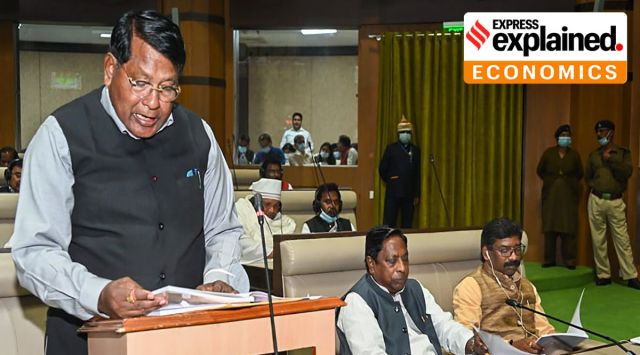Explained: Jharkhand’s Economic Survey report
The per capita income in the state is one of the lowest in the country. It ranked 26th of the 28 states of the country since its formation in the year 2000-01.
 Jharkhand Finance Minister Rameshwar Oraon presents the state budget 2022-23 at the Jharkhand Assembly budget session, in Ranchi. (PTI)
Jharkhand Finance Minister Rameshwar Oraon presents the state budget 2022-23 at the Jharkhand Assembly budget session, in Ranchi. (PTI)Jharkhand’s economy is estimated to grow at 8.8 per cent in this fiscal, as per the Economic Survey released on March 2. It said the Gross State Domestic Product (GSDP) contracted by 4.7 per cent from FY 20 to FY 21, i.e from Rs 2.38 lakh crore to Rs 2.27 lakh crore (both provisional data). The Survey estimated the GSDP at Rs 2.47 lakh crore in FY 22 (the current financial year) and estimated it to reach Rs 2.62 lakh crore at 6.15 per cent the next fiscal. The GDP measures the ‘economic activity from the demand side by looking at the expenditures made by different sections of the society.’
🗞️ Subscribe Now: Get Express Premium to access the best Election reporting and analysis 🗞️
What is the per capita income of Jharkhand?
The per capita income in the state is one of the lowest in the country. It ranked 26th of the 28 states of the country since its formation in the year 2000-01. Only UP and Bihar were behind it. In 2019-20, Jharkhand’s per capita income remained ahead of only three states i.e Manipur, Uttar Pradesh and Bihar. After the contraction, the per capita decreased to Rs 53, 489 in FY 21 at constant prices and is estimated to be close to pre-pandemic levels. In FY 22, Rs 57,287 crore is estimated as per capita income.
How about the Gross Value Added (GVA) of the state?
The GVA ‘measures economic activity from the supply side by looking at the value added by different sectors of the economy’. The share of the primary sector – agriculture, forestry, fishing and mining and quarrying – has declined from 28 per cent in FY 12 to 23.3 per cent in FY 21. The share of the secondary sector – manufacturing, electricity, gas, water supply and construction – has remained stable at around 33 per cent, while the share of tertiary sector – hospitality, real estate, financial services, trade, repair among others – have grown from 38.5 per cent to 43.7 per cent in the same period. The survey pointed out that the decrease in the share of agricultural sector with the ‘growth of economy is universal’ because of technological limitations among others, however, it added that in Jharkhand the decrease in share of the agriculture sector is because of ‘less optimal performance of the sector’. It stated that there is ample scope for improvement in the performance through expansion of the area under cultivation and augmentation and technology adoption among others.
What is the inflation rate in Jharkhand?
The rate of inflation has remained below 6 per cent. The survey says that it has remained low mainly because of the gap between the inflation rate of urban and rural areas. The states with less urbanisation have a lower inflation rate, stated the survey.
What is the condition of poverty in Jharkhand?
The survey cited Niti Aayog’s report, which used the National Family Health Survey data -IV, pegging the multi-dimentional poor in rural areas 50.93 per cent and urban areas at 15.26 per cent. The index is a composite index of 12 indicators such as nutrition, access to drinking water among others. The Survey, however, emphised that a ‘lot of progress has been made in these indicators after the data of 4th round of the NFHS-4 was released”. “Thus the multi-dimesnional poverty index report based in NFHS-V is expected to show a sharper reduction”, it said.
What has been the state’s fiscal development and finances?
The size of the state’s budget has grown 12 times since its formation. Last year the state presented a budget of Rs 91,277 crore. In terms of revenue, in the financial year 2020-21, the total revenue receipts of the state was about Rs 56,149 crore. Under this, the tax revenue (which is State’s share in Central Taxes + its own tax revenue such as land, excise, commercial tax) stood at Rs 36,592 crore while non-tax revenue stood at Rs 19, 557.4 crore. The capital receipt was at Rs 14,356.4 crore. For FY 22 (BE), it is estimated to be Rs 45,315.4 crore as total tax revenue and Rs 31,391.5 crore as non tax revenue.
Newsletter | Click to get the day’s best explainers in your inbox
Photos





- 01
- 02
- 03
- 04
- 05

































